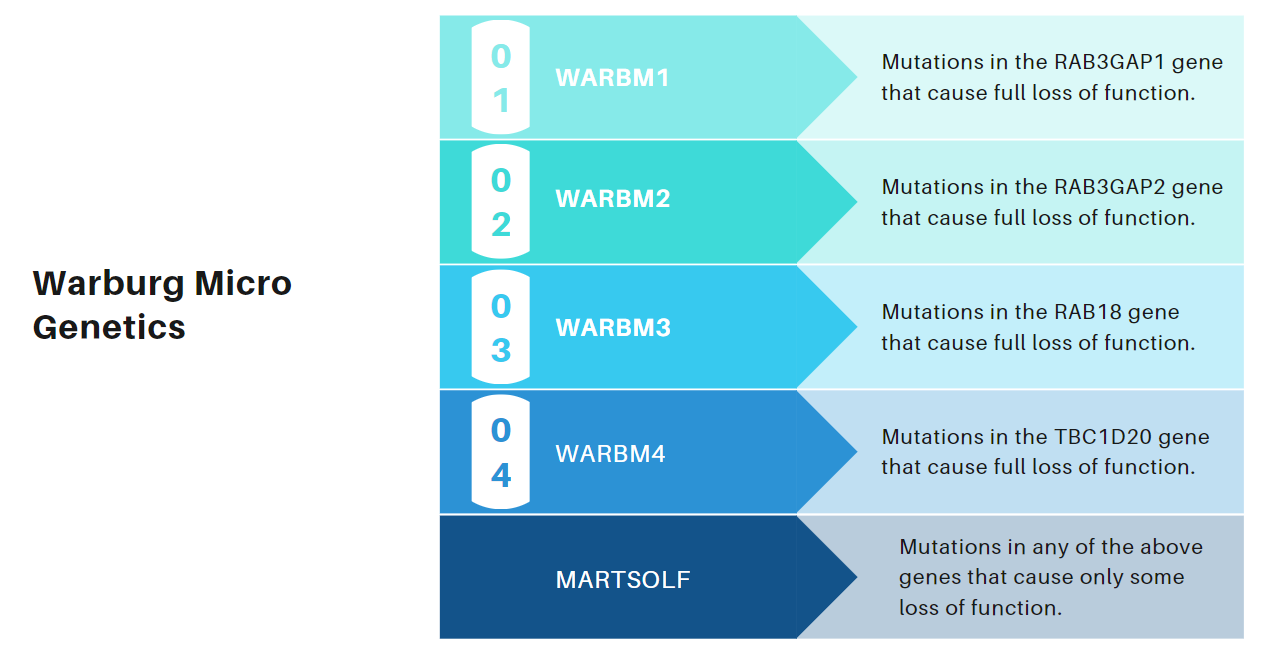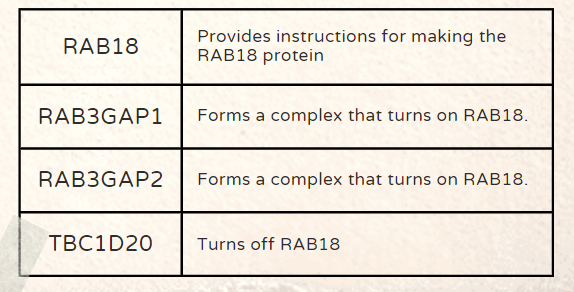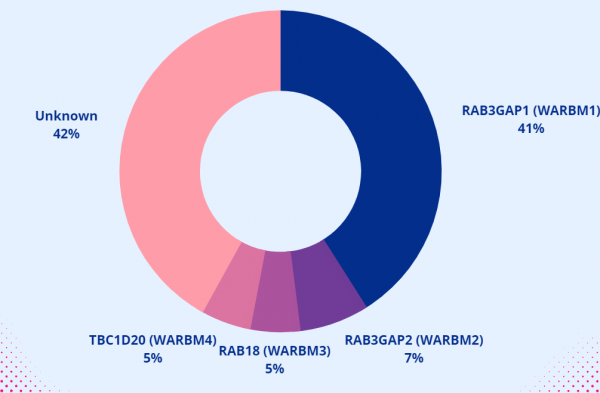What is WARBM1?
WARBM1, WARBM2, WARBM3, WARBM4...... what do they mean?

What is the difference between WARBM1, 2, 3, & 4 outcomes?
WARBM1, WARBM2, WARBM3, and WARBM4 have different genetic causes.
However WARBM1, 2, 3, &4 all have an “indistinguishable phenotype”– meaning they have the same symptoms.
Why do different genes cause the same symptoms?
The RAB18 gene provides instructions for making the RAB18 protein. The other genes provide instructions for making proteins that regulate the activity of the RAB18 protein.

How common is each type?
RAB3GAP1 mutations are by far the most common in literature, but among many children with symptoms consistant with the disorder, no known changes are found.

How do I know it's Warburg Micro or Martsolf syndrome?
RAB3GAP2 (WARBM2) was at first thought to cause milder symptoms than other types. Later though, that was considered incorrect.
Mutation types, not genes cause Martsolf syndrome.
This happens when a genetic mutation only reduces a gene’s function rather than completely eliminating it. A patient’s symptoms are milder because some of the gene is still working.
Missense or splicing variants may still allow some function of the gene.
Of 102 studied patients confirmed genetically, 98 were considered Warburg and 4 Martsolf.
Symptoms of Martsolf vs symptoms or Micro
- – Intellectual disability is usually “mild to moderate” in Marstolf, and “severe to profound” in Micro
- – Skills like walking and talking are attained in some, but not all, Martsolf cases between age 2-5
- – Brain malformations, cataracts, and micropthalmia are present in both.
- – Spasticity and optic atrophy are also present in both, but worsen more slowly in Marstolf.
Why do they have different names?
Because the symptoms of Wabrug Micro and Martsolf overlap so much, researchers and clinicians believe the disorder is not two separate disorders, but instead a spectrum.
They have suggested renaming the disorder RABopathies or Rab 18 deficiency. ,
Handley, M. T., Morris-Rosendahl, D. J., Brown, S., Macdonald, F., Hardy, C., Bem, D., Carpanini, S. M., Borck, G., Martorell, L., Izzi, C., Faravelli, F., Accorsi, P., and 23 others. Mutation spectrum in RAB3GAP1, RAB3GAP2, and RAB18 and genotype-phenotype correlations in Warburg Micro syndrome and Martsolf syndrome. Hum. Mutat. 34: 686-696, 2013.
Liegel RP, Handley MT, Ronchetti A, Brown S, Langemeyer L, Linford A, et al. Loss-of-function mutations in TBC1D20 cause cataracts and male infertility in blind sterile mice and Warburg micro syndrome in humans. Am J Hum Genet. 2013;93(6):1001–14. https://doi.org/10.1016/j.ajhg.2013.10.011.
McKusick VA., ed. Online Mendelian Inheritance in Man (OMIM). Baltimore. MD: The Johns Hopkins University; Entry No:600118; Last Update: 11/07/2017. Available at: http://omim.org/entry/600118 Accessed March 19, 2022.
“Rab18 deficiency”. https://medlineplus.gov/genetics/condition/rab18-deficiency
Hozhabri H, Talebi M, Mehrjardi MYV, De Luca A, Dehghani M. Martsolf syndrome with novel mutation in the TBC1D20 gene in a family from Iran. Am J Med Genet A. 2020 May;182(5):957-961. doi: 10.1002/ajmg.a.61543. Epub 2020 Mar 12. PMID: 32162791. https://pubmed.ncbi.nlm.nih.gov/32162791/
Last updated: 6/24/2022
Disclaimer: Families should consult a medical professional for genetic diagnosis, management and health concerns. We provide external links to help families and caregivers find additional information- this should not imply our endorsement or responsibility for their content.
Disclaimer.
